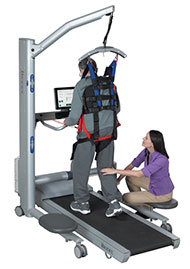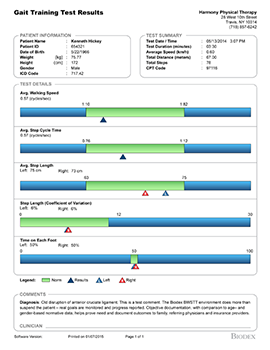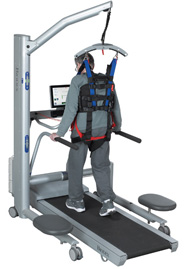Beyond audio cueing and visual biofeedback, music-enhanced gait training promotes neuroplasticity. Prove patients are getting better, faster.
The only treadmill with an instrumented deck that monitors and records step length, step speed and step symmetry, the Gait Trainer 3 lets you prove patients are getting better, faster – and documents results.
 More than a treadmill, the Biodex Gait Trainer 3 puts evidence-based techniques at your fingertips. By combining audio cueing, visual biofeedback and music-assisted therapy integration, the Gait Trainer 3 helps promote neuroplasticity… creating new pathways to movement.
More than a treadmill, the Biodex Gait Trainer 3 puts evidence-based techniques at your fingertips. By combining audio cueing, visual biofeedback and music-assisted therapy integration, the Gait Trainer 3 helps promote neuroplasticity… creating new pathways to movement.
Biofeedback Improves Patient Outcomes
The addition of real-time visual biofeedback has been shown to motivate patients, prompting them into proper gait patterns.1 Only the Biodex Gait Trainer 3 provides a comparison of actual footfall to target step length. This real-time biofeedback helps patients stay on target in each phase of rehabilitation.
|
Multiple Applications with a Single Investment Beyond the many features and applications for gait training, this dual mode device can also be used as a traditional rehabilitation treadmill with speed range up to 10 mph. |
Neurologic Music Promotes Correct Movement
Music-based therapy is well researched for its powerful effects in treating movement disorders. By integrating rhythmic auditory cueing (RAC) and a library of neurologic music compositions, Biodex takes gait training to a whole new level. Learn More.
The Biodex Gait Training System
Allow every patient the opportunity to get an early start on rehabilitation. Combine the Gait Trainer and NxStep Unweighing System for body weight-supported treadmill training (BWSTT) with unobstructed view and access to the patient.
| Reference | |
| 1 | Journal of Rehabilitation Medicine |

Goal: Develop symmetrical gait by improving step length, step speed and right to left time distribution.
Method:
Have the patient walk at a comfortable step speed concentrating on symmetry of step length and step time. Once the patient has developed symmetry and cardiovascular gains, begin to work towards normative gait parameters. As an option, support the patient in the Biodex Unweighing System to provide a no-fall environment.
Results and Benefits:
When combined with the Unweighing System:
Allows concentration on treatment, not physically supporting the patient.
Reference:
American Geriatrics Society, British Geriatrics Society and American Academy of Orthopedic Surgeons Panel on Falls Prevention, Guideline for the Prevention of Falls in Older Persons, April 5, 2001.
Cress ME, Buchner DM, Questad KA, Essel PC, daLateur BJ, Schwartz RS. Continuous-scale physical functional performance in healthy older adults: a validation study. Arch Phys Med Rehabil 1996; 77:1234-50
Simpson JM, Harrington R, Marsh N., Guidelines for Managing Falls Among Elderly People. Physiotherapy, 84:4;173-177 April 1998.
Wolfson L. Whipple R, Amerman P, Tobin JN. Gait Assessment in the Elderly: A Gait Abnormality Rating Scale and its Relation to Falls. J of Gerontology 1990; 45:M12-19

Method:
Utilize audio cues and biofeedback to develop step length symmetry and right to left time distribution. Initially support patient’s body weight using the Biodex Unweighing System. Set treadmill belt in reverse direction (retro-walking) to assist with gains in range of motion. Forward direction of belt works on symmetry of step length and step time.
Results and Benefits:
When combined with the Unweighing System:
Reference:
American Geriatrics Society, British Geriatrics Society and American Academy of Orthopedic Surgeons Panel on Falls Prevention, Guideline for the Prevention of Falls in Older Persons, April 5, 2001.
Cress ME, Buchner DM, Questad KA, Essel PC, daLateur BJ, Schwartz RS. Continuous-scale physical functional performance in healthy older adults: a validation study. Arch Phys Med Rehabil 1996; 77:1234-50
Method:
Progressively address step speed and right to left time distribution. Use a slow initial belt speed (.10 cycles/sec – .50 cycles/sec). Clinician may assist with paretic limb placement to initiate step length. Visual cues are used initially to reinforce step length. Once step symmetry is reached, gait speed can be addressed.
Results and Benefits:
When combined with the Unweighing System:
Reference:
Barbeau, et al., Walking After Spinal Cord Injury: Control and Recovery
Gardner et al., Partial Body Weight Support with Treadmill Locomotion
Visintin et al., A New Approach to Retrain Gait in Stroke Patients Through Body Weight Support and Treadmill Stimulation
Suzuki et al., Determinants and predictors of the maximum walking speed during computer assisted gait training in hemiparetic stroke patients.
Suzuki et al., Relationship between stride length and walking rate in gait training for hemiparetic stroke patients.
Method:
Initially, concentrate on developing step length symmetry. Once symmetry is achieved, increase speed of the treadmill for progression towards normative gait parameters specific to the age, gender and leg length of the patient.
Results and Benefits:
When combined with the Unweighing System:
Reference:
Barbeau et al., Walking After Spinal Cord Injury: Control and Recovery
Gardner et al., Partial Body Weight Support With Treadmill Locomotion….
Visintin et al., A New Approach to Retrain Gait In Stroke Patients Through Body Weight Support and Treadmill Stimulation
Suzuki et al., Determinants and predictors of the maximum walking speed during computer assisted gait training in hemi paretic stroke patients. Suzuki et al., Relationship between stride length and walking rate in gait training for hemi paretic stroke patients.
Method:
Using audio and visual cues, initially concentrate on developing step length symmetry with focus on right to left time distribution. Once symmetry is achieved, increase speed of the treadmill for progression towards normative gait parameters specific of the age, gender and leg length of the patient.
Results and Benefits:
Reference:
Peterson et al., Physiological responses during unweighted ambulation of three patients with below the knee amputation: A pilot study.
Method:
Utilize audio and visual cues to assist the retraining of the temporal and spatial deficits associated with Parkinsonian Gait. The patient focuses on the visual and audio cues, which help to regulate step length.
Results and Benefits:
When combined with the Unweighing System:
Reference:
Morris et al., Stride Length Regulation in Parkinson’s Disease
*Does not accommodate less than 60 lb in gait trainer mode.
| 950-400 | Gait Trainer™ 3, 115 VAC 50/60 Hz* Includes Support Bar |
| 950-402 | Gait Trainer™ 3, 115 VAC 50/60 Hz* Includes Extended Handrails |
| 950-406 | Gait Trainer™ 3, 115 VAC 50/60 Hz* Includes Geriatric/Pediatric Handrails |
* Includes printer and printer stand. Export models available. US Patent 6,645,126 B1
| 950-413 | Music-Assisted Therapy Package Compatible with Gait Trainer 3 featuring Windows OS. Includes music library and sound bar with input for headphones and microphone. |
Course Presented by
Dr. Kevin E. Wilk

Sport Medical
PO Box 390419
Mountain View, CA
94039
Tel: (800) 224-6339
Int Tel: +1-631-924-9000
Fax: (631) 924-8355
©Sport Medical Technology, Inc. 2025